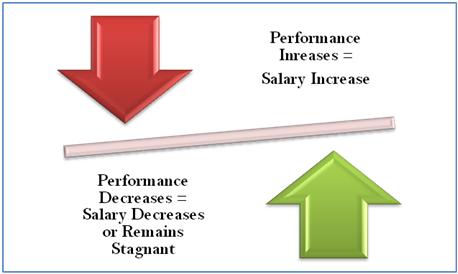Most HR professionals whose organizations have a pay-for-performance compensation philosophy cringe at the thought of implementing a general increase—that is, an across-the-board standard pay increase. But are there times when general increases should be considered in spite of an organization's pay-for-performance philosophy? Before shunning the idea, companies should dig further into the considerations regarding budget constraints, market trends and other internal and external factors.
Budget Constraints
There are times when limited budgets for salary increases impact the decision to provide merit increases under a pay-for-performance model. For example, if a company has only a 1 percent budget to allocate throughout the organization, the intent of rewarding performance could be negated by the low amount of the reward.
Organizations should consider whether the variance among increases is substantial enough to incentivize changes in behavior. In other words, if the difference in merit increases between a high performer and a low performer is only 0.25 percent, organizations should consider whether their employees will really work harder to be rated as a high performer. Compensation consultants advise that under a true pay-for-performance system, there must be statistically significant differences between the percentages of salary increases that individuals can receive tied to their performance ratings. Companies might want to distinguish at least a full percent difference among the amounts distributed at each rating level.
To ensure that the different increases incentivize higher performance, run an analysis using performance ratings alongside the percentage of merit increase received. Other factors for comparison should include years of related experience and compa-ratios. If true pay for performance exists, the following chart should hold true, with a correlation between higher performance and higher salaries.

Market Trends
Other considerations regarding whether or not to roll out a general increase should include emerging changes within the market. Below are key questions that an organization should be asking:
- What are companies in comparable industries doing regarding salary increases?
- What are the average budgets for salary increases in the market (broken out by merit pools, promotions budgets, etc.)?
- Are companies giving a general increase in addition to a merit-based increase?
- What types of general increases are organizations giving?
By answering these questions, an organization will be better prepared to decide what actions to take.
Other Internal and External Factors
Among additional internal and external factors to weigh include:
Compensation actions by job classifications. Companies with multiple job classifications (for example, bargaining unit positions vs. nonbargaining positions) need to think further about how general increases affect different groupings of positions. For instance, if a collective bargaining agreement requires a regular cost-of-living adjustment (COLA), how does that impact the salaries of nonbargaining positions? Another point of reference should be evaluating compression among pay classification. For instance, if technicians have not been getting the same type of increases as janitors and market survey data shows that technicians are valued higher than janitors, perhaps a general increase to all technicians is warranted.
COLA indicators. While a COLA increase might be common practice for some organizations, others might consider whether their pay is out of line with the market as a result of not providing a COLA. Several indicators that compensation managers can use to research this issue are listed in the table below.
Indicator
Purpose
Option for obtaining info
Consumer Price Indexes (CPI) or Cost of Living Indexes
These measure the changes in price of various goods and services and provide a basis for comparing cost of living and income disparities.
CPI reports are available from the U.S. Bureau of Labor Statistics (BLS) at www.bls.gov.
State Minimum Wage
Minimum wage changes are not just essential for compliance but also can be a threshold for analysis with other market pay data.
Current and historic data for minimum wages is accessible from the U.S. Department of Labor at www.dol.gov/whd/minwage/america.htm.
Inflation Rate
The rate of inflation is correlated with changes in the CPI. This data can serve as a tool along with cost-of-living indexes when considering a COLA. In addition, inflation can be a strong benchmark when aging-up outdated compensation survey data.
A calculator is available from the BLS at www.bls.gov/data/inflation_calculator.htm.
Wage Determinations
Changes within applicable wage determinations (for instance, under the Service Contract Act and the Davis-Bacon Act) might help management identify if there have been significant changes to pay in job classifications and locations.
Wage determinations provided by federal agencies can be viewed at www.wdol.gov.
Compensation practices should remain flexible in light of ever-changing internal and external factors. The rollout of a general increase might be a good fit with an organization’s strategies despite a pay-for-performance philosophy. When considering a general increase, decision-makers should never say never. Instead, they should gather the most relevant data to decide on the best course of action for their organization.
Juliet Rohrer, MBA, SPHR, CCP is an HR professional in Washington state. Her areas of interest include compensation, benefits, compliance, retention and recruiting, and building HR’s role as a strategic partner within organizational structure and communications.
Related Articles:
Ensure the Strategic Use of Stock-Based Pay, SHRM Online Compensation Discipline, May 2012
Matching Jobs with Pay, HR Magazine, May 2012
What Is a Compensation Philosophy, SHRM Templates and Tools, April 2012
Research Challenges Use of Performance Measurement Bell Curve, SHRM Online Compensation Discipline, March 2012
Study: Pay for Performance Pays Off, SHRM Online Compensation Discipline, September 2011
How to Use 'Carve-Outs' to Truly Pay for Performance, SHRM Online Compensation Discipline, June 2011
Pay for Performance: Make It More than a Catch-Phrase, SHRM Online Compensation Discipline, May 2011
All for Incentives, Incentives for All, HRMagazine, January 2011
Quick Links:
SHRM Online Compensation Discipline
SHRM Metro Economic Outlook reports
• Sign up for SHRM’s free Compensation & Benefits e-newsletter |
Advertisement
An organization run by AI is not a futuristic concept. Such technology is already a part of many workplaces and will continue to shape the labor market and HR. Here's how employers and employees can successfully manage generative AI and other AI-powered systems.
Advertisement


